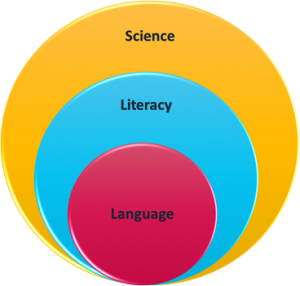 ELA and Science Are NOT Different Subjects
ELA and Science Are NOT Different Subjects
Actually, they are different subjects, but not as much as they are often treated in schools. Many teachers report (and the research confirms) that in preschool and elementary schools there is very little or even no discretionary time to teach science; literacy and math take up the majority of the school day. Yet, there is great potential for making connections between science and literacy, but it requires strong understanding of both of these domains.
Scientists must describe their observations both orally and in writing (and drawing).
They must talk about what they are thinking with their colleagues, and must communicate to a wider audience.
They must read about what others have observed and thought.
In order to do all of this they must be skilled at oral and written language, and reading for meaning. Each of these skill areas are covered in the Common Core and most, if not all, states’ learning standards. In short, science is a great vehicle for helping children become better talkers, writers, readers and thinkers. When they DO science, children and scientists engage in the practices of both science and literacy and children are able to experience science as a way of thinking and as a collaborative, communicative discipline.
Our approach to early science emphasizes ways teachers and families can make strong, authentic connections between science, language, and literacy. Personally- meaningful science experiences motivate children to communicate and provide a rich context for helping them develop skills across the domains. We focus on the role of talk as central to science, and pay particular attention to helping adults ask questions that facilitate children’s thinking and encourage discourse.
The Role of Language in Science Learning
Science is a wonderful vehicle for developing language. This is true for native English speakers and Dual-language learners alike. When science is taught in a hands-on and minds-on manner, teachers and families can help describe their observations, share their experiences, and explain their ideas in English or a home language. Research has confirmed that young students who are learning English as a second or even third language can do well in science when they have opportunities to express their thinking in the language most comfortable for them to use. We encourage teachers to consider how they can promote a classroom culture that treats dual language learning as an asset rather than a deficit.
“…research suggests that a shift is needed by recognizing the assets that ELs bring to the classroom and understanding that some deficits in student performance arise from lack of access and not from limited ability, language proficiency, or cultural differences.”
English Learners in STEM Subjects: Transforming Classrooms, Schools, and Lives (2018, p2). National Academies Press
